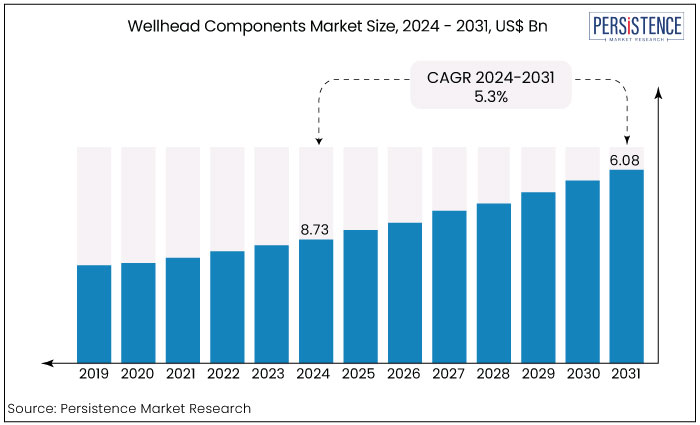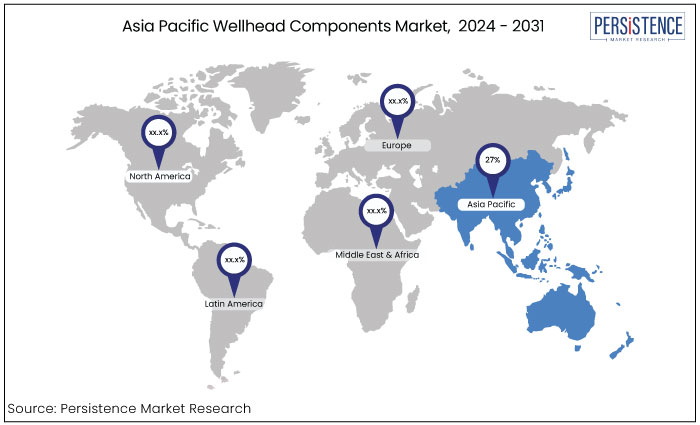ID: PMRREP34796| 174 Pages | 18 Sep 2024 | Format: PDF, Excel, PPT* | Energy & Utilities

The wellhead components market is estimated to increase from US$6.08 Bn in 2024 to US$8.73 Bn by 2031. The market is projected to capture a CAGR of 5.3% during the forecast period from 2024 to 2031. The recent research and development activities for the advancements in automation and digital technologies are enhancing wellhead performance and efficiency. The rising interest in the adoption of unconventional oil and gas reserves drives the market forward.

Key Highlights of the Market
|
Market Attributes |
Key Insights |
|
Market Size (2024E) |
US$6.08 Bn |
|
Projected Market Value (2031F) |
US$8.73 Bn |
|
Global Market Growth Rate (CAGR 2024 to 2031) |
5.3% |
|
Historical Market Growth Rate (CAGR 2019 to 2023) |
4.3% |
|
Region |
Market Share in 2023 |
|
Asia Pacific |
27% |
Asia Pacific market led with sales share of over 27% in 2023 and continues to dominate the market. Technological innovations and the implementation of sophisticated drilling methods in the region are driving market expansion.
Countries like Australia and Japan are investing in advanced drilling methods for deep water and ultra-deepwater exploration, hence increasing the demand for specialist wellhead components.
The advancement of coalbed methane (CBM) and shale gas resources in nations like China and India is generating new prospects for manufacturers of wellhead components. The wellhead components market in China is projected to achieve a high CAGR rate from 2024 to 2031. China's industrial capabilities and cost-effectiveness are pivotal to its market supremacy.
Manufacturers in China have established sophisticated production facilities and methodologies, enabling the fabrication of high-quality wellhead components at competitive prices. This cost advantage has fulfilled domestic demand and allowed Chinese enterprises to export their products internationally.

|
Category |
Market Share in 2024 |
|
Product - Hangers |
30% |
Based on product, the market is divided into hangers, flanges, master value, and casing head. Among these, hangers segment dominates the market. Hangers are essential elements of a wellhead assembly that bear the weight of the casing or tubing string and seal the annular area between the casing strings.
Hangers are available in multiple varieties such as slip and mandrel hangers and are essential for preserving structural integrity and pressure regulation. Flanges are coupling devices employed to unite pipes, valves, and additional apparatus in a wellhead system. They offer a secure and impermeable connection capable of enduring elevated pressures and temperatures.
Flanges are available in diverse dimensions, pressure classifications, and materials to accommodate various operational situations. They are crucial for constructing modular wellhead assemblies that may be readily maintained or altered as required.
|
Category |
Market Share in 2024 |
|
Application - Onshore |
80% |
The market is divided into onshore and offshore based on application. Among these, onshore segment dominates the market accounting for 80% of the total market share in 2024. Onshore wellhead components are utilized in terrestrial oil and gas production activities. These components are engineered to endure the pressures and conditions commonly experienced in onshore drilling settings.
Onshore wellheads often possess less complex configurations than offshore wellheads as they do not require consideration of elements like water depth or marine conditions. The onshore segment typically experiences elevated demand because of the larger quantity of terrestrial wells and the comparative accessibility for maintenance and operations.
There is an escalating demand for efficient and dependable wellhead equipment to facilitate exploration and production operations with the increase in energy consumption especially in developing nations. Technological innovations in drilling methods like hydraulic fracturing and horizontal drilling have been significant catalysts for the sector. These technologies have facilitated oil and gas extraction from previously unreachable deposits, resulting in heightened drilling operations in unconventional regions.
The shale gas boom in North America has generated increased demand for wellhead components capable of enduring the elevated pressures and temperatures linked to these extraction techniques. The increasing emphasis on offshore and deep-water exploration favours the wellhead components market.
Oil and gas corporations progressively resort to offshore resources to satisfy global energy requirements as readily available onshore reserves diminish. This transition necessitates specialized wellhead components that function dependably in severe marine conditions and at significant depths.
The advancement of offshore fields in areas like the Gulf of Mexico, the North Sea, and the Brazilian coast has significantly propelled wellhead technology and component design advancements.
Before 2023, the wellhead components market experienced steady growth largely driven by increased oil and gas exploration activities. Rising global demand for energy particularly from developing countries spurred the need for new drilling operations boosting the market.
Technological advancements in wellhead equipment designed to improve safety and efficiency further propelled market expansion. The recovery of crude oil prices after their downturn in 2020 also incentivized more upstream activities.
Environmental concerns and the transition toward renewable energy created some headwinds, with oil and gas companies facing pressure to adopt cleaner technologies. Despite these challenges, the need for reliable and high-performance wellhead components particularly in deepwater and unconventional drilling sustained market growth.
Post-2024, the market is expected to grow more dynamically fueled by ongoing global energy demand and continued exploration of new oil fields. Technological innovations in wellhead components that enhance automation, safety, and operational efficiency will play a significant role.
Increasing deepwater and ultra-deepwater drilling activities particularly in regions like Latin America and Africa are expected to drive demand further. The market will likely to see a surge in investment in gas exploration as natural gas gains prominence as a cleaner energy alternative. However, regulatory pressures and environmental concerns may temper long-term growth in some regions.
Increased Exploration and Production Activities
Surge in the oil and gas sector in exploration and production activities is a primary driver for the wellhead components market. As global energy demand rises particularly from emerging economies, oil and gas companies invest heavily in exploring new reserves and developing existing fields. This significantly focuses on challenging environments such as deep-water and ultra-deep water drilling.
Wellhead components are crucial for the safety and efficiency of these operations, providing essential functions such as pressure control and well integrity management. The drive to access untapped reserves and optimize production from aging fields necessitates advanced wellhead technologies.
The oil and gas industry's continuous exploration and expansion efforts create a consistent demand for high-quality wellhead components driving market growth.
Shift Toward Natural Gas and Clean Energy Sources
The shift toward natural gas as a clean energy source is driving growth in the wellhead components market. Natural gas is increasingly favoured over oil due to its lower carbon emissions and its role as a transition fuel toward renewable energy sources. This shift is stimulating investment in gas exploration and production including the development of new gas fields and the enhancement of existing infrastructure.
Wellhead components play a critical role in managing the specific requirements of gas extraction such as handling different pressure levels and ensuring safe operation. The growing emphasis on natural gas aligns with global efforts to reduce greenhouse gas emissions leading to increased demand for wellhead technologies tailored for gas applications. This trend is expected to continue boosting market growth as energy companies invest in gas-related wellhead systems and infrastructure.
Fluctuating Oil Prices and Economic Uncertainty
Fluctuating oil prices pose a significant restraint for the wellhead components market. The oil and gas industry is highly sensitive to changes in crude oil prices, which can impact investment levels in exploration and production activities.
Periods of low oil prices often lead to budget cuts, project delays, and reduced capital expenditure by oil and gas companies. This directly affects the demand for wellhead components, as lower investment in new drilling projects and maintenance can lead to decreased sales.
Economic uncertainty driven by geopolitical events, trade tensions, or global financial instability can exacerbate these fluctuations leading to unpredictable market conditions. As a result, wellhead component manufacturers may face challenges in maintaining steady growth and profitability in an environment where oil prices are volatile and capital investment is constrained.
Regulatory and Environmental Challenges
Regulatory and environmental challenges present another significant restraint for the wellhead components market. The oil and gas industry faces increasing scrutiny regarding its environmental impact leading to stringent regulations and standards for drilling operations and equipment. Compliance with these regulations often requires substantial investment in technology and modifications to existing wellhead systems.
The push toward sustainable and clean energy sources mean that traditional oil and gas operations may face high costs or operational restrictions. These regulatory pressures can increase the cost of wellhead components and limit market opportunities particularly in regions with stringent environmental policies.
The need to balance compliance with environmental standards and operational efficiency can create financial and operational challenges for wellhead component manufacturers and oil and gas operators.
Advancements in Digital and Automation Technologies
One of the most transformative opportunities in the market is the integration of digital and automation technologies. Modern wellhead systems increasingly incorporate advanced sensors, IoT (Internet of Things) connectivity, and automation to enhance operational efficiency and safety.
Technologies allow for real-time monitoring, data collection, and predictive maintenance, which can significantly reduce downtime and operational costs. For instance, automated systems can adjust operational parameters based on real-time data improving the management of pressure and flow rates in wells.
Implementing digital technologies also facilitates remote operation and control, which is especially valuable in remote or hazardous environments. As the oil and gas industry continues to embrace digital transformation, the demand for wellhead components equipped with advanced technology is expected to rise. Consequently, creates substantial growth opportunities for manufacturers.
The market is competitive and features a mix of global and regional players. Leading companies include Schlumberger, Halliburton, Baker Hughes, Weatherford, and National Oilwell Varco (NOV) known for their advanced technologies and extensive product portfolios.
The key industry leaders offer a wide range of wellhead components designed for various drilling and production environments. Specialized firms like Tenaris and Cameron (a Schlumberger company) provide niche products and solutions.
The market is characterized by technological innovation, with companies focusing on automation, digital integration, and advanced materials to enhance performance. Competitive strategies include mergers and acquisitions, partnerships, and continuous research and development to stay ahead in the evolving oil and gas sector.
Recent Industry Developments in the Wellhead Components Market
By Product
By Application
By Region
The market is driven by the growing shift toward natural gas.
Advancements in digital and automation technologies presents a key opportunity for the market players.
The market is projected to exhibit a CAGR of 5.3% during the forecast period from 2024 to 2031.
Asia Pacific region holds the largest market share of the market.
A few of the leading players in the market are Valveworks USA, TSI Flow Products, and Canary.
|
Attributes |
Details |
|
Forecast Period |
2024 to 2031 |
|
Historical Data Available for |
2019 to 2023 |
|
Market Analysis |
US$ Billion for Value |
|
Key Regions Covered |
|
|
Key Market Segments Covered |
|
|
Key Companies Profiled in the Report |
|
|
Report Coverage |
|
|
Customization & Pricing |
Available upon request |
Delivery Timelines
For more information on this report and its delivery timelines please get in touch with our sales team.
About Author